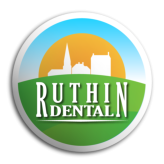Ruthin Dental © 2023 Website designed and maintained by H G Web Designs


Pariatur sint in sunt sit ullamco, adipisicing sed sunt non incididunt cillum eu veniam occaecat deserunt.
RUTHIN DENTAL
WELCOME TO

Frequently Asked Questions
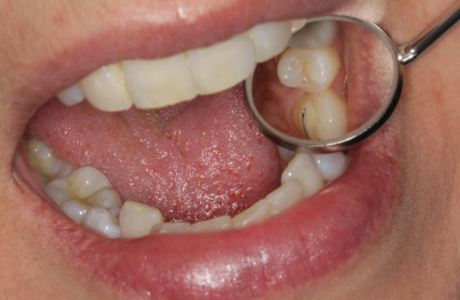
1. Why do I need a dental check up?
A dental check up allows your dentist to check on the health of your
mouth. They will look at the teeth, gums and mouth for signs of
disease, carry out an oral cancer screening and see if there have
been any changes since your last check up. They will ask about and
advise on diet, smoking and alcohol use and teeth cleaning habits.
Leaving problems untreated can make them more difficult to treat.
Tooth decay and gum disease are preventable and it is best to
prevent problems occurring or deal with them early. The dentist will
advise you when to book your next exam. This may vary depending
upon the assessment the dentist makes of the risk of a dental
problem developing.
2. What are the benefits of composite fillings?
Composite fillings are metal free, natural looking and match the shade of your tooth. The material bonds to your tooth so there is minimum tooth
preparation. At the end of your appointment the fillings will be fully set and polished.
The filling materials we use are BPA free.



Examination
Effective Dose
(msv)
Theoretical Cancer Risk
Equivalent time of Average UK Background
Dental Bitewing X-
ray
0.005
1 in 4,000,000
16 hours
Panoramic OPT X-
ray
0.02
1 in 1,000,000
3 days
Lumbar Spine X-ray
0.7
1 in 30,000
Over 3 months
CT Brain Scan
3
1 in 6,500
More than 1 year
CT Body Scan
20
1 in 1,000
8 years
3. PATIENT INFORMATION ON DENTAL X-RAYS BENEFITS AND RISKS
DENTAL X-RAY EQUIPMENT
Dentists may use different types of x-ray equipment- from simple devices used to take an image of the structure of a single tooth to panoramic or a
specialist type of CT scanner used to take more detailed images of the mouth or jaw. The equipment is used to diagnose conditions that may not be
apparent from a visual examination.
RADIATION DOSE
All types of equipment send an x-ray beam through the mouth to create an image on a piece of film or digital media. Whilst much of the x-ray beam
goes onto the film or plate, some of the energy is absorbed by the body. This is the radiation ‘dose’ that we would receive from the examination. The
dose can be expressed in a number of different ways, but perhaps the most common is the Sievert (Sv). Because diagnostic x-ray examinations
uses relatively small doses (particularly so in dentistry), these doses are usually stated as milliSievert (mSv) one thousandth of a Sievert.
DOSE AND RISK
We receive a small radiation dose all the time from a range of natural sources- including the sun and stars; the things we eat and drink; common
building materials; and the earth and rocks. The back ground radiation dose is on average about 2.7mSv per year in the UK, but varies
considerably from place to place, being over 7mSv per year in Cornwall, for example. As seen from the table below, the additional dose received
from a dental x-ray examination is very small and has negligible influence on the theoretical risk of radiation triggering a cancer.
By comparison, 1 in 2 people born in the UK after 1960 will be diagnosed with cancer during their lifetime. (Source: Cancer Research UK).
LEGISLATION AND STANDARDS
Nevertheless, the use of x-rays in dental practices is subject to strict sets of regulations and professional standards in the interest of both patient
and staff safety. Amongst many other things they cover:
•
Ensuring x-rays are only preformed when necessary- they need to be fully justified.
•
Installation maintenance and testing of x-ray equipment to ensure it continues to function correctly.
•
Appointing an external expert (the practice’s Radiation Protection Adviser/medical Physics Expert) to advise on patient and staff safety and
to check that the equipment produces consistent quality images whilst keeping radiation doses to an acceptable level.
DENTAL X-RAYS AND PREGNANCY
The dental x-ray beam is small, highly directional and of course never directed towards the abdomen. The radiation dose the patient receives is not
transmitted by the circulation. The consequence of all this it is entirely safe to have a dental x-ray during pregnancy, so there is no need for the
dentist to ask the pregnancy status of someone having a dental x-ray.
This information was produced on the 15/03/18 by Kim Parry (radiation protection supervisor at Ruthin Dental Practice) in conjunction with the
practice’s Radiation Protection Advisor (Graham Hart). The contents of this sheet will be reviewed on request by the practice and at least once
every three years by the Radiation Protection Advisor.
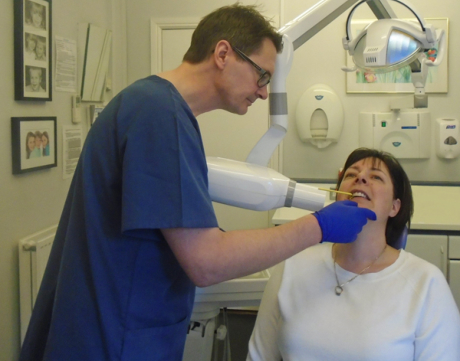
4. What do you do if a tooth gets knocked out in an accident?
http://www.nhs.uk/conditions/broken-tooth/Pages/Introduction.aspx
1. Find the tooth.
2. Hold the tooth by the crown
3. Lick the tooth clean if it’s dirty, or rinse it in water
4. Put it back into position (adult teeth only), never try to insert a baby
tooth
5. Bite on a handkerchief to hold the tooth in place
6. Go to see your dentist as an emergency
If you can’t put the tooth back, put it in milk and see a dentist straight
away.
The sooner a knocked-out tooth is re-implanted the more likely it is to
be successful.
Do not try and re-implant a baby tooth as it could damage the
permanent tooth underneath. See a dentist.
We asked Joy, Heather and Becky, our hygienist and therapists for their advice for the following frequently asked questions.
6. What is a dental therapist?
A dental therapist works along side the dentist to carry out routine dental treatment such as fillings under the prescription of a dentist. They are
unable to diagnose dental treatment but patients can directly access the therapist or hygienist for routine hygiene visits.
7. I clean my teeth twice a day. What can the hygienist do that I can’t?
Regular professional cleaning removes plaque and tartar from your teeth and gums.
We also give you advice on how to look after your teeth and gums at home including
demonstrations of the best techniques and dietary advice. This involves helping with
any techniques you are struggling with and highlighting areas you may be unaware
you are missing.
Each visit is tailored to suit the individual personally and identifies problems such as
gum disease, toothbrush abrasion, acid erosion etc.
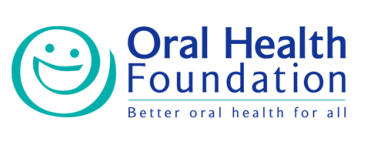
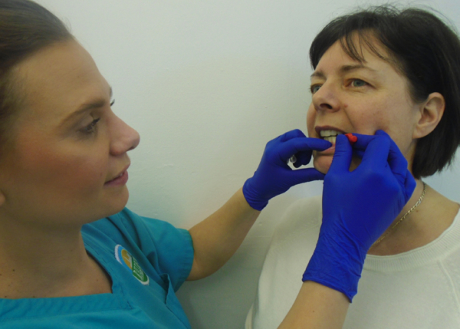
8. There are so many toothpastes. How do I know which one to
choose?
Most toothpastes are equally effective in maintaining your dental health.
Some toothpastes are designed to tackle certain problems such as
sensitivity, whitening, tartar control. We recommend toothpaste that
contains fluoride, check the back of the box.
•
New born to 3yr 1000ppm - a smear on the tooth brush
•
3 to 6yrs - adult toothpaste but a small pea size amount,
encourage the child to spit out
•
adult 1450-1500 ppm - a pea sized amount
Choose a toothpaste that you will enjoy using twice a day which
addresses your particular needs.
Remember to spit not rinse!
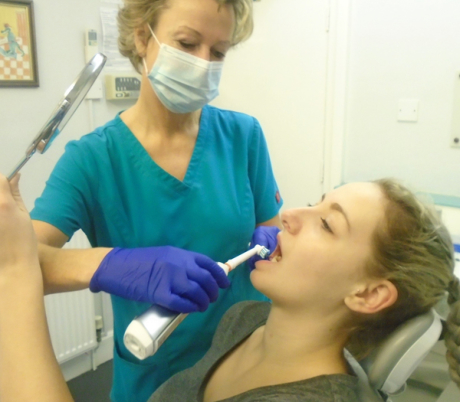
9. What is plaque and what harm can it do?
Plaque is a sticky film that builds up on your teeth. It contains bacteria
which causes gum inflammation.
If left this build up will harden and form tartar. This may lead to gum
disease and eventual tooth loss. Leaving plaque on your teeth can also
lead to tooth decay and bad breath.
10. Are electric toothbrushes better than manual ones?
Studies prove that electric brushes remove 11% more plaque than a
manual brush and significantly reduce gum disease.
Braun Oral B electric brushes are proven to improve brushing and we
regularly see this in patients that start using them compared to a manual
toothbrush. The head size is smaller, and it rotates and oscillates. It (the
brush) does the brushing action for you making plaque removal easier
and more effective
The correct technique is important - ask your hygienist to demonstrate
how to use one correctly.
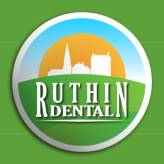
Pariatur sint in sunt sit ullamco, adipisicing sed sunt non incididunt cillum eu veniam occaecat deserunt.

RUTHIN DENTAL
WELCOME TO
Frequently Asked Questions
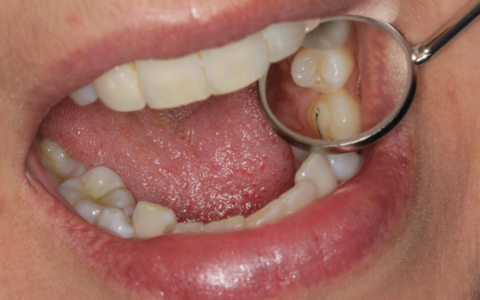
1. Why do I need a dental check up?
A dental check up allows your dentist to check on the health of your
mouth. They will look at the teeth, gums and mouth for signs of disease,
carry out an oral cancer screening and see if there have been any
changes since your last check up. They will ask about and advise on diet,
smoking and alcohol use and teeth cleaning habits. Leaving problems
untreated can make them more difficult to treat. Tooth decay and gum
disease are preventable and it is best to prevent problems occurring or
deal with them early. The dentist will advise you when to book your next
exam. This may vary depending upon the assessment the dentist makes
of the risk of a dental problem developing.
2. What are the benefits of composite fillings?
Composite fillings are metal free, natural looking and match the shade of
your tooth. The material bonds to your tooth so there is minimum tooth
preparation. At the end of your appointment the fillings will be fully set and
polished.
The filling materials we use are BPA free.



Exami-
nation
Effective
Dose (msv)
Theoretical
Cancer Risk
Equivalent time of Average
UK Background
Dental
Bitewing
X-ray
0.005
1 in 4,000,000
16 hours
Panoram
ic OPT X-
ray
0.02
1 in 1,000,000
3 days
Lumbar
Spine X-
ray
0.7
1 in 30,000
Over 3 months
CT Brain
Scan
3
1 in 6,500
More than 1 year
CT Body
Scan
20
1 in 1,000
8 years
3. PATIENT INFORMATION ON DENTAL X-RAYS BENEFITS AND RISKS
DENTAL X-RAY EQUIPMENT
Dentists may use different types of x-ray equipment- from simple devices
used to take an image of the structure of a single tooth to panoramic or a
specialist type of CT scanner used to take more detailed images of the
mouth or jaw. The equipment is used to diagnose conditions that may not
be apparent from a visual examination.
RADIATION DOSE
All types of equipment send an x-ray beam through the mouth to create an
image on a piece of film or digital media. Whilst much of the x-ray beam
goes onto the film or plate, some of the energy is absorbed by the body.
This is the radiation ‘dose’ that we would receive from the examination.
The dose can be expressed in a number of different ways, but perhaps the
most common is the Sievert (Sv). Because diagnostic x-ray examinations
uses relatively small doses (particularly so in dentistry), these doses are
usually stated as milliSievert (mSv) one thousandth of a Sievert.
DOSE AND RISK
We receive a small radiation dose all the time from a range of natural
sources- including the sun and stars; the things we eat and drink; common
building materials; and the earth and rocks. The back ground radiation
dose is on average about 2.7mSv per year in the UK, but varies
considerably from place to place, being over 7mSv per year in Cornwall,
for example. As seen from the table below, the additional dose received
from a dental x-ray examination is very small and has negligible influence
on the theoretical risk of radiation triggering a cancer.
By comparison, 1 in 2 people born in the UK after 1960 will be diagnosed
with cancer during their lifetime. (Source: Cancer Research UK).
LEGISLATION AND STANDARDS
Nevertheless, the use of x-rays in dental practices is subject to strict sets
of regulations and professional standards in the interest of both patient
and staff safety. Amongst many other things they cover:
•
Ensuring x-rays are only preformed when necessary- they need to
be fully justified.
•
Installation maintenance and testing of x-ray equipment to ensure it
continues to function correctly.
•
Appointing an external expert (the practice’s Radiation Protection
Adviser/medical Physics Expert) to advise on patient and staff safety
and to check that the equipment produces consistent quality images
whilst keeping radiation doses to an acceptable level.
DENTAL X-RAYS AND PREGNANCY
The dental x-ray beam is small, highly directional and of course never
directed towards the abdomen. The radiation dose the patient receives is
not transmitted by the circulation. The consequence of all this it is entirely
safe to have a dental x-ray during pregnancy, so there is no need for the
dentist to ask the pregnancy status of someone having a dental x-ray.
This information was produced on the 15/03/18 by Kim Parry (radiation
protection supervisor at Ruthin Dental Practice) in conjunction with the
practice’s Radiation Protection Advisor (Graham Hart). The contents of this
sheet will be reviewed on request by the practice and at least once every
three years by the Radiation Protection Advisor.
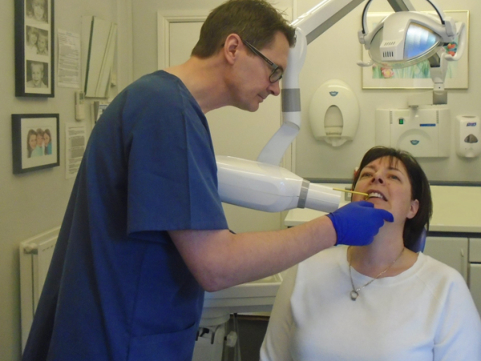
4. What do you do if a tooth gets knocked out in an accident?
http://www.nhs.uk/conditions/broken-tooth/Pages/Introduction.aspx
1. Find the tooth.
2. Hold the tooth by the crown
3. Lick the tooth clean if it’s dirty, or rinse it in water
4. Put it back into position (adult teeth only), never try to insert a baby
tooth
5. Bite on a handkerchief to hold the tooth in place
6. Go to see your dentist as an emergency
If you can’t put the tooth back, put it in milk and see a dentist straight
away.
The sooner a knocked-out tooth is re-implanted the more likely it is to
be successful.
Do not try and re-implant a baby tooth as it could damage the
permanent tooth underneath. See a dentist.
We asked Joy, Heather and Becky, our hygienist and therapists for
their advice for the following frequently asked questions.
6. What is a dental therapist?
A dental therapist works along side the dentist to carry out routine dental
treatment such as fillings under the prescription of a dentist. They are
unable to diagnose dental treatment but patients can directly access the
therapist or hygienist for routine hygiene visits.
7. I clean my teeth twice a day. What can the hygienist do that I can’t?
Regular professional cleaning removes plaque and tartar from your teeth
and gums.
We also give you advice on how to look after your teeth and gums at home
including demonstrations of the best techniques and dietary advice. This
involves helping with any techniques you are struggling with and
highlighting areas you may be unaware you are missing.
Each visit is tailored to suit the individual personally and identifies
problems such as gum disease, toothbrush abrasion, acid erosion etc.

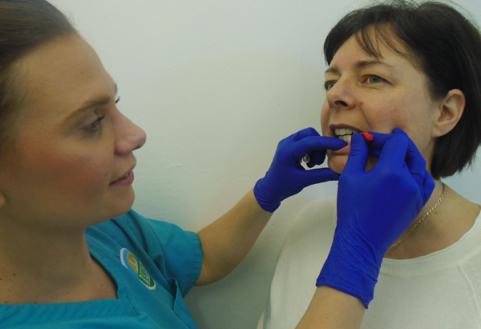
8. There are so many toothpastes. How do I know which one to
choose?
Most toothpastes are equally effective in maintaining your dental health.
Some toothpastes are designed to tackle certain problems such as
sensitivity, whitening, tartar control. We recommend toothpaste that
contains fluoride, check the back of the box.
•
New born to 3yr 1000ppm - a smear on the tooth brush
•
3 to 6yrs - adult toothpaste but a small pea size amount,
encourage the child to spit out
•
adult 1450-1500 ppm - a pea sized amount
Choose a toothpaste that you will enjoy using twice a day which
addresses your particular needs.
Remember to spit not rinse!
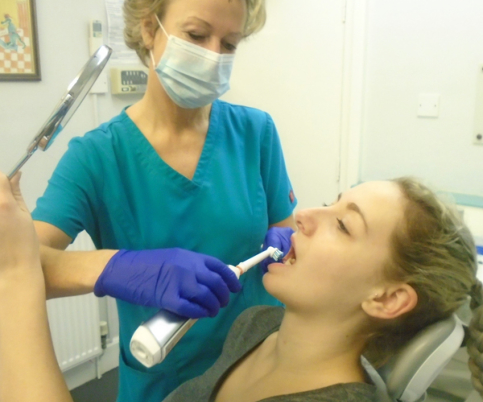
9. What is plaque and what harm can it do?
Plaque is a sticky film that builds up on your teeth. It contains bacteria
which causes gum inflammation.
If left this build up will harden and form tartar. This may lead to gum
disease and eventual tooth loss. Leaving plaque on your teeth can also
lead to tooth decay and bad breath.
10. Are electric toothbrushes better than manual ones?
Studies prove that electric brushes remove 11% more plaque than a
manual brush and significantly reduce gum disease.
Braun Oral B electric brushes are proven to improve brushing and we
regularly see this in patients that start using them compared to a manual
toothbrush. The head size is smaller, and it rotates and oscillates. It (the
brush) does the brushing action for you making plaque removal easier
and more effective
The correct technique is important - ask your hygienist to demonstrate
how to use one correctly.





































